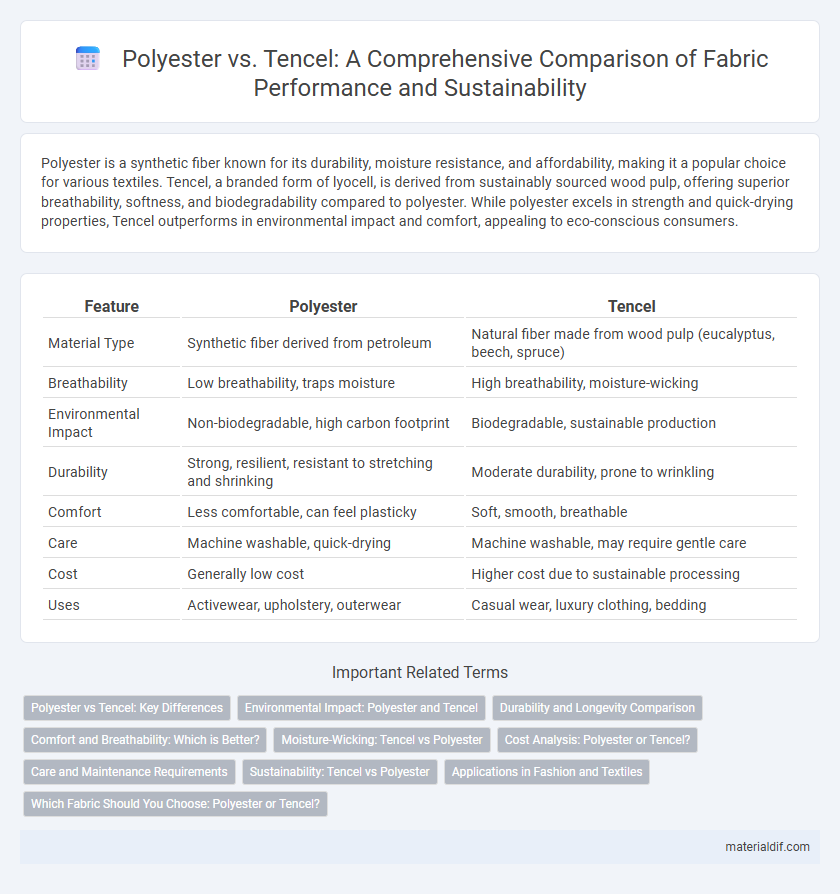Polyester is a synthetic fiber known for its durability, moisture resistance, and affordability, making it a popular choice for various textiles. Tencel, a branded form of lyocell, is derived from sustainably sourced wood pulp, offering superior breathability, softness, and biodegradability compared to polyester. While polyester excels in strength and quick-drying properties, Tencel outperforms in environmental impact and comfort, appealing to eco-conscious consumers.
Table of Comparison
| Feature | Polyester | Tencel |
|---|---|---|
| Material Type | Synthetic fiber derived from petroleum | Natural fiber made from wood pulp (eucalyptus, beech, spruce) |
| Breathability | Low breathability, traps moisture | High breathability, moisture-wicking |
| Environmental Impact | Non-biodegradable, high carbon footprint | Biodegradable, sustainable production |
| Durability | Strong, resilient, resistant to stretching and shrinking | Moderate durability, prone to wrinkling |
| Comfort | Less comfortable, can feel plasticky | Soft, smooth, breathable |
| Care | Machine washable, quick-drying | Machine washable, may require gentle care |
| Cost | Generally low cost | Higher cost due to sustainable processing |
| Uses | Activewear, upholstery, outerwear | Casual wear, luxury clothing, bedding |
Polyester vs Tencel: Key Differences
Polyester is a synthetic fiber made from petroleum-based products, known for its durability, wrinkle resistance, and moisture-wicking properties, whereas Tencel is a natural fiber derived from eucalyptus wood pulp, prized for its biodegradability, breathability, and softness. Polyester tends to be less breathable and less environmentally friendly due to its non-biodegradable nature and reliance on fossil fuels, while Tencel offers superior moisture management and a lower environmental impact through sustainable production processes. The choice between Polyester and Tencel often depends on balancing performance needs with environmental considerations, where Polyester excels in affordability and strength, and Tencel provides comfort and eco-conscious benefits.
Environmental Impact: Polyester and Tencel
Polyester, a synthetic fiber derived from petroleum, has a high environmental impact due to its reliance on non-renewable resources and its contribution to microplastic pollution in oceans. Tencel, produced from sustainably sourced eucalyptus wood through a closed-loop process, offers a biodegradable alternative with significantly lower water and carbon footprints. The contrasting production methods highlight Tencel's advantage in reducing ecological damage compared to the energy-intensive, non-biodegradable nature of polyester.
Durability and Longevity Comparison
Polyester offers superior durability and resistance to stretching, shrinking, and abrasion compared to Tencel, making it a long-lasting fabric ideal for high-wear applications. Tencel, derived from sustainable wood pulp, is softer and more breathable but tends to break down faster with repeated washing and exposure to sunlight. Choosing polyester ensures extended garment lifespan, while Tencel prioritizes eco-friendly comfort over maximum durability.
Comfort and Breathability: Which is Better?
Polyester fibers are known for durability and water resistance but often lack breathability compared to natural fibers. Tencel, derived from eucalyptus pulp, offers superior moisture-wicking properties and enhanced airflow, leading to greater comfort in warm conditions. When prioritizing breathability and softness, Tencel outperforms polyester by effectively regulating body temperature and reducing sweat accumulation.
Moisture-Wicking: Tencel vs Polyester
Tencel fibers exhibit superior moisture-wicking properties compared to polyester, as their natural cellulosic structure efficiently absorbs and releases moisture, keeping the skin dry. Polyester, being a synthetic fiber, tends to trap sweat and moisture, leading to less breathability and potential discomfort during extended wear. This makes Tencel a preferred choice for activewear and breathable fabrics where moisture management is crucial.
Cost Analysis: Polyester or Tencel?
Polyester generally costs less than Tencel, making it a more budget-friendly option for manufacturers and consumers seeking affordable fabrics. Tencel, derived from sustainably sourced wood pulp, commands a higher price due to its eco-friendly production process and superior softness. When analyzing cost, polyester offers economic efficiency, while Tencel provides added value through sustainability and comfort, impacting pricing decisions in textile sourcing.
Care and Maintenance Requirements
Polyester is wrinkle-resistant and machine washable, requiring minimal maintenance compared to Tencel, which demands delicate care such as hand washing or gentle machine cycles to prevent fiber damage. Polyester dries quickly and resists shrinking, while Tencel, being cellulose-based, is prone to shrinkage and requires air drying to maintain fabric integrity. Both fabrics benefit from low-heat ironing if necessary, but Tencel's natural fibers make it more susceptible to pilling and wear over time.
Sustainability: Tencel vs Polyester
Tencel, derived from sustainably sourced eucalyptus wood, boasts superior biodegradability and a lower environmental footprint compared to conventional polyester, which is petroleum-based and contributes significantly to microplastic pollution. The closed-loop production process of Tencel recycles water and solvents, reducing waste and energy consumption, whereas polyester manufacturing relies heavily on non-renewable resources and emits greenhouse gases. Choosing Tencel over polyester supports sustainable fashion practices by minimizing chemical use and enhancing fabric compostability.
Applications in Fashion and Textiles
Polyester dominates the fashion and textile industry due to its durability, wrinkle resistance, and cost-effectiveness, making it ideal for mass-produced garments and activewear. Tencel, derived from sustainably sourced wood pulp, is favored for its softness, breathability, and moisture-wicking properties, positioning it as a premium choice in eco-conscious apparel and luxury textiles. Designers often select polyester for versatile everyday wear, while Tencel is preferred for high-end, sustainable collections emphasizing comfort and environmental impact.
Which Fabric Should You Choose: Polyester or Tencel?
Polyester offers durability, moisture resistance, and affordability, making it ideal for activewear and budget-friendly clothing. Tencel, derived from sustainably sourced wood pulp, provides superior breathability, softness, and biodegradability, appealing to eco-conscious consumers. Choose Polyester for long-lasting performance and easy care, while Tencel suits those seeking comfort and sustainable textile options.
Polyester vs Tencel Infographic

 materialdif.com
materialdif.com